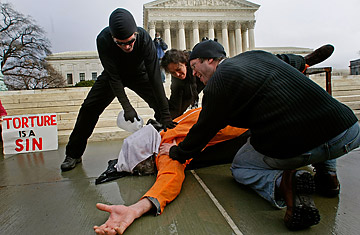
Activists demonstrate "water boarding" technique during a protest in front of the U.S. Supreme Court.
As the curtain falls on the Bush Administration, one set piece of the Administration's policy on torture has finally been ushered offstage. The Bybee Memo, a 2002 opinion authored by the Justice Department's Office of Legal Counsel, was brushed aside last week by a federal judge overseeing the nation's first-ever criminal trial of an American accused of torture abroad. The public defenders representing torture suspect Chucky Taylor, a U.S. citizen and the son of former Liberian military strongman Charles Taylor, submitted it for consideration as part of potential jury instructions. But Federal Judge Cecilia Altonaga rejected the terms laid out in the memo, saying, "I will not give an instruction that relies upon that memorandum as its authority."
It was a humiliating epilogue to the Bush Administration's attempt to integrate what many critics describe as undeniable torture into U.S. military and intelligence policy. The Bybee memo, (named for Jay Bybee, then head of the Office of Legal Counsel) was largely authored by John Yoo, then Deputy Assistant Attorney General of the Office of General Counsel. It provided legal guidance for civilians engaged in interrogating terrorism suspects. Administration officials feared that CIA employees and other nonmilitary personnel could face indictment under the federal law that upholds U.S. obligation to the United Nations Convention Against Torture. The memo narrowly defined torture as an act "equivalent in intensity to the pain accompanying serious physical injury, such as organ failure, impairment of bodily function, or even death."
From the outset, critics of the memo viewed the legal thinking behind it as flawed. Then Navy general counsel Alberto Mora identified it as a "dangerous document" that "spots some of the legal trees, but misses the constitutional forest. Because it identifies no boundaries to action — more, it alleges there are none — it is virtually useless as guidance." What particularly troubled Mora and other critics of the memo was that, as a document from the Office of Legal Counsel, its opinions were binding as the Administration's interpretation of the law.
The memo was eventually rescinded after Mora and other critics raised objections directly to the Pentagon leadership that was developing detainee interrogation procedures. It was resurrected by Taylor's defense attorneys in their attempt to win acquittal for their client, in the apparent belief that it could provide legal cover to the acts he was accused of committing, which included electrocution of genitals, melting plastic onto a victim's flesh, pouring scalding water on a victim's hands. Instead, Judge Altonaga summarily dismissed the memo and, on Oct. 27, Taylor, an American citizen, was convicted on five counts of torture under a law known as the extraterritorial torture statute. The judge ultimately relied on the December 2004 Office of Legal counsel opinion that replaced the Bybee Memo, one that defines torture as "an act committed by a person acting under color of law specifically intended to inflict severe physical pain and suffering other than pain and suffering incident to lawful sanctions."
Rejected now by both court and bureaucracy, the Bybee Memo may have no effective existence. But its notoriety is certain to outlive this Administration. Indeed, critics believe it will be part of the Bush legacy. Says Martin Lederman, visiting professor with the Georgetown University Law Center and former adviser to the Office of Legal Counsel: "the memo will be seen as one of the most extreme deviations from the rule of law and from the President's obligation to take care that the law is faithfully executed."
